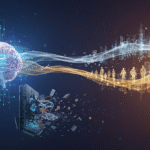By 2035, corporate landscapes will have evolved dramatically, reshaped by artificial intelligence, pervasive automation, and hyper-connectivity. Central to this seismic shift is the transformation of the Chief Information Officer’s (CIO) role and their direct reports, comprising the main structure of IT departments. Continuing the focus on business impact and strategy enablement that Innovation Vista is doing our small part to accelerate, by 2035 the CIO will have ascended the corporate hierarchy to occupy a strategic position equal in stature to the Chief Financial Officer (CFO), Chief Revenue Officer (CRO), and Chief Operating Officer (COO). This new reality will demand CIOs adopt a highly strategic and business-oriented mindset, guiding technological investments directly linked to competitive advantage and corporate growth.
We believe that for most midsize and larger companies the elevated CIO role will orchestrate a powerful leadership cadre, including the Chief Technology Officer (CTO), Chief Artificial Intelligence Officer (CAIO), Chief Data Officer (CDO), Chief Information Security Officer (CISO), and Chief Human Resources Officer (CHRO). Each of these executives will oversee teams transformed by technological advancements, particularly AI and microservices architecture, radically shifting the structure and priorities of IT and human capital management functions.
Chief Technology Officer (CTO): Infrastructure and Automation
By 2035, the CTO will manage highly specialized teams dedicated to digital infrastructure, leveraging extensive microservices architectures to maintain flexibility and responsiveness. Traditional IT roles like system administrators and help desk personnel will sharply decline as AI-driven automation significantly reduces the need for manual intervention. Instead, specialized teams will emerge focused on “AI Infrastructure Management,” responsible for deploying, maintaining, and tuning AI models embedded in corporate IT systems.
Expect about 25% of IT staffing/vendor spend to be allocated to the CTO’s division, with a primary focus on highly skilled specialists who manage automated infrastructure, cloud optimization, and AI-driven operational efficiency.
Chief Artificial Intelligence Officer (CAIO): Governance and Innovation
As AI permeates every business function, the CAIO will become a pivotal role, reporting directly to the CIO. This role will oversee “AI Model Governance and Tuning” teams tasked with monitoring and refining AI models deployed across corporate functions, ensuring transparency, bias mitigation, compliance, and ethical AI use.
In addition, dedicated “AI Innovation Labs” will drive strategic experimentation and rapid deployment of advanced models to maintain competitive leadership. By 2035, approximately 20% of IT spend will flow to the CAIO, investing heavily in data scientists, AI ethics specialists, and governance analysts.
Chief Data Officer (CDO): Data Stewardship and Integration
The Chief Data Officer will assume responsibility for enterprise-wide data quality, integration, and strategic utilization. The importance of data curation and stewardship will surge, driven by AI’s voracious appetite for quality inputs. Expect large-scale “Data Operations Teams,” including Data Curators, Data Quality Specialists, and Data Integration Experts, operating as internal service providers to ensure clean, accessible, and trustworthy data.
The CDO’s function will command around 15% of staffing/vendor spend, concentrated on ensuring seamless data interoperability, quality assurance, and agile response to data-driven business insights.
Chief Information Security Officer (CISO): Automated Security and Compliance
As technological complexity expands, so too does the attack surface, rendering cybersecurity even more vital. The CISO’s office will encompass “AI-driven Security Operations Centers” (SOC) and “Automated Threat Response Units,” leveraging sophisticated predictive analytics and real-time threat assessment tools.
Additional teams dedicated to “Compliance and Risk Management” will systematically oversee privacy regulation adherence, secure AI model deployments, and digital ethics enforcement. Spending under the CISO will hover around 15%, emphasizing automation and predictive threat mitigation capabilities.
Chief Human Resources Officer (CHRO): Human Capital and AI Integration
In perhaps the most transformative shift we are forecasting, traditional Human Resources functions will be entirely subsumed within IT by 2035. Advanced Human Capital Management (HCM) and Continuous Learning Management (CLM) systems powered by AI will handle onboarding, training, payroll, benefits administration, performance tracking, and recruitment autonomously.
This evolution will produce teams centered around “Employee Experience and AI Interface Design,” ensuring intuitive, empathetic, and highly personalized interactions for employees engaging with automated HR systems. “AI Ethics and Bias Mitigation Teams” will scrutinize HR-related AI deployments, ensuring fairness and equitable treatment across diverse employee populations.
We expect that approximately 25% of staffing/vendor spend will be dedicated to HR under the CHRO, particularly emphasizing AI specialists, user-experience designers, and ethics analysts who humanize automated interactions.
The Culmination of Forces Already Underway
We believe that by 2035, corporate IT org-charts will mirror the strategic elevation of technology and data-driven insights as foundational to business success. Under the CIO’s strategic leadership, the CTO, CAIO, CDO, CISO, and CHRO will each oversee distinctly evolved functions, driven by AI advancements and microservices architecture. Reduced need for manual IT support will redirect resources toward data curation, AI management, cybersecurity automation, and the integration of HR into IT, creating a leaner yet exponentially more capable and strategically focused IT workforce poised to drive the future of corporate innovation and growth.




